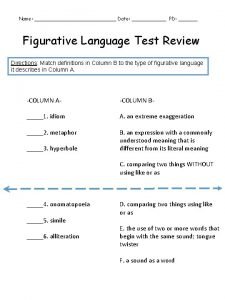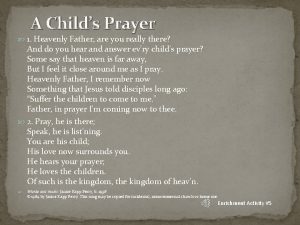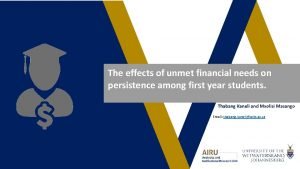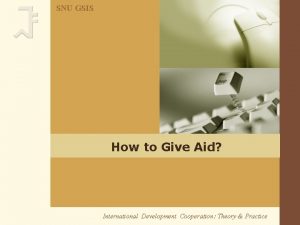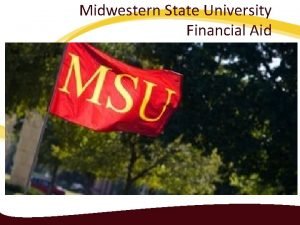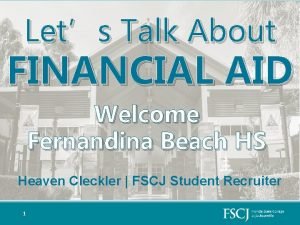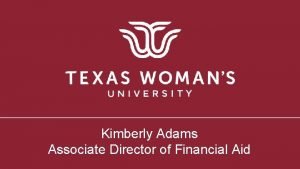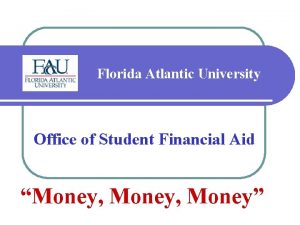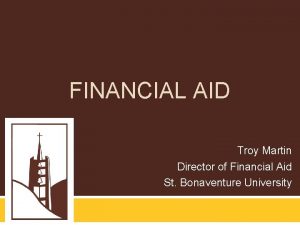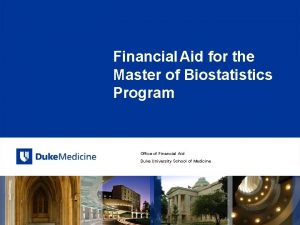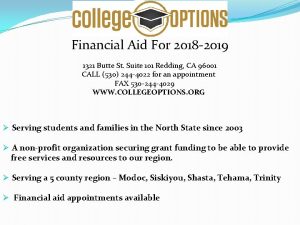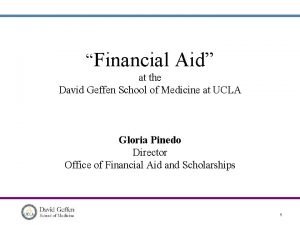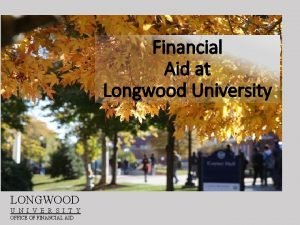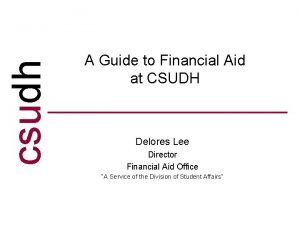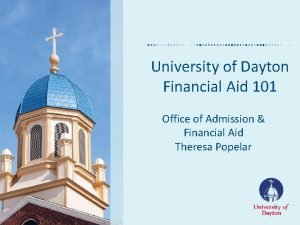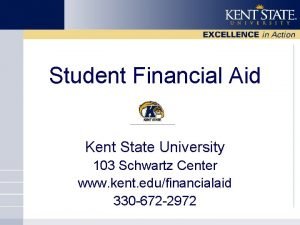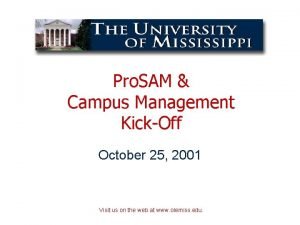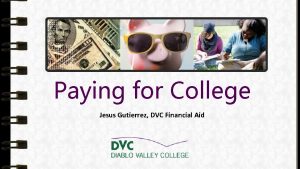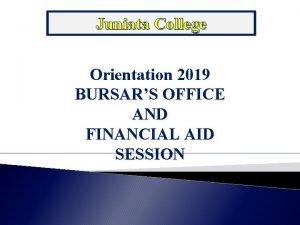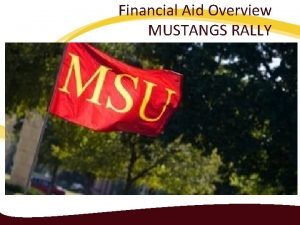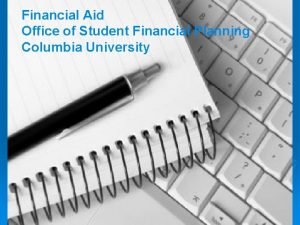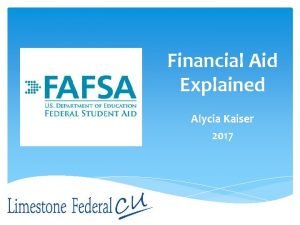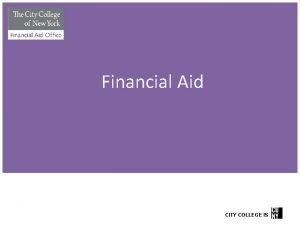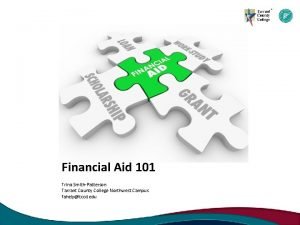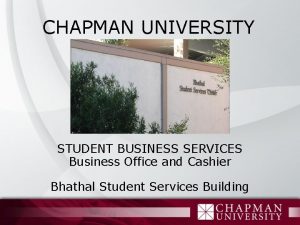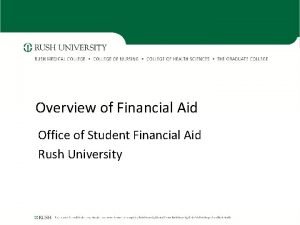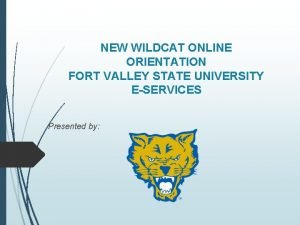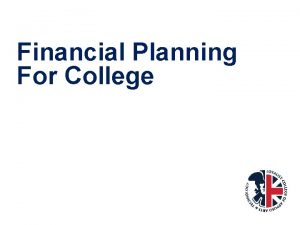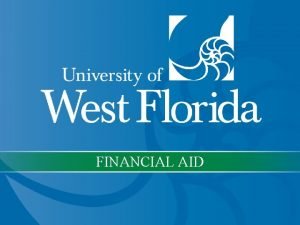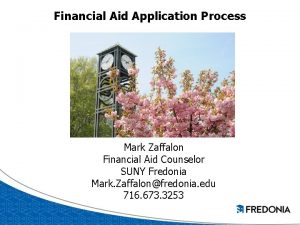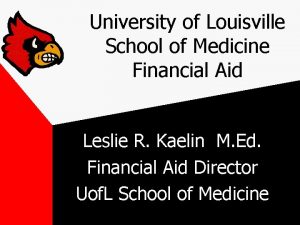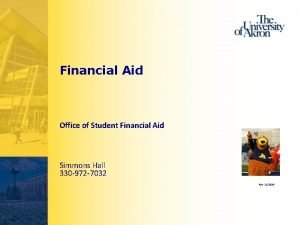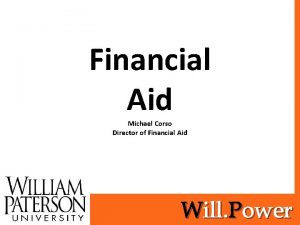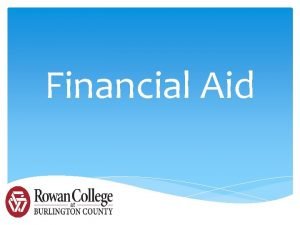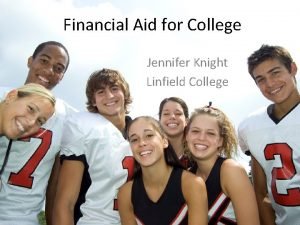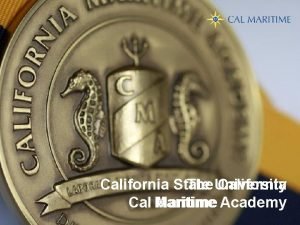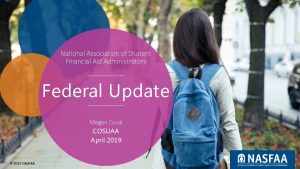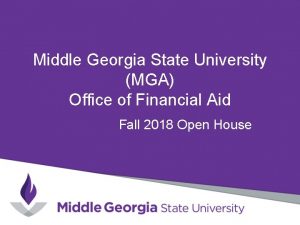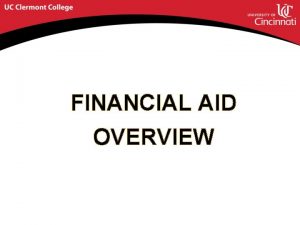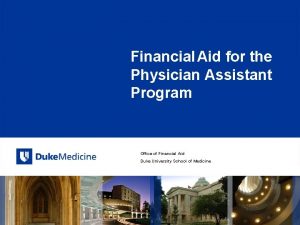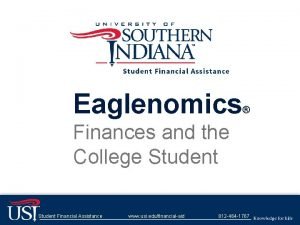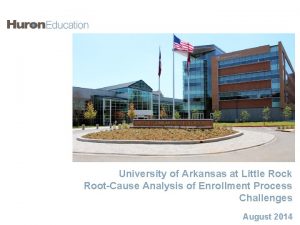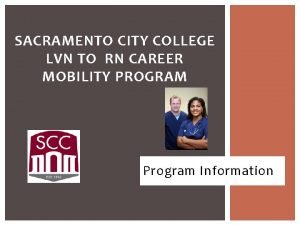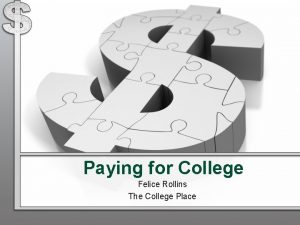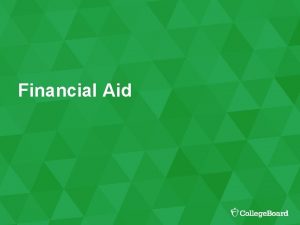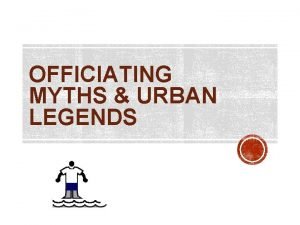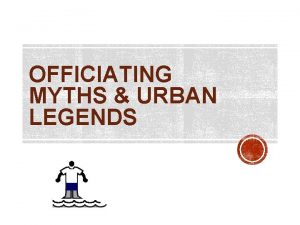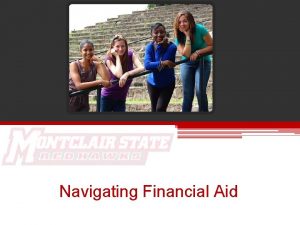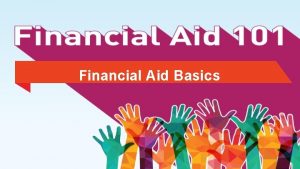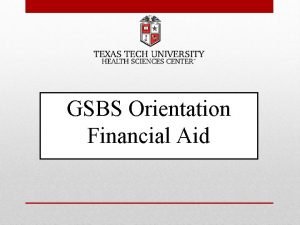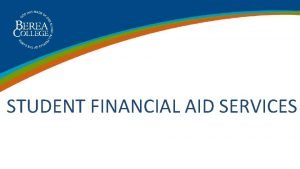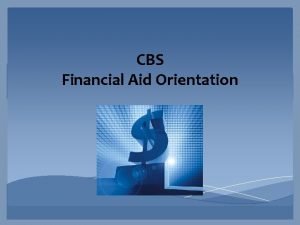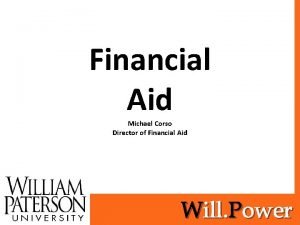Financial Aid Myths Tips What you really need


































































- Slides: 66

Financial Aid Myths & Tips: What you really need to know! David D. Page Vice President for Enrollment Management Dillard University Brother Martin High School TUESDAY, SEPTEMBER 26, 2017 1

Topics of Discussion What is financial aid? Cost of attendance (COA) Expected family contribution (EFC) Financial need Categories, types, and sources of financial aid Free Application for Federal Student Aid (FAFSA) • Special circumstances • • • 2

What is Financial Aid? 3

What is Financial Aid? • Financial aid consists of funds provided to students and families to help pay for postsecondary educational expenses – Scholarships – Grants – Loans – Work Study 4

Sources of Financial Aid • Federal government • States • Colleges and universities • Private sources • Civic organizations and churches • Employers 5

Federal Government • Largest source of financial aid • Aid awarded primarily on the basis of financial need • Must apply each year using the FAFSA 6

State of Louisiana • Residency requirements usually apply • Award aid on the basis of both merit and need • Use information from the FAFSA and/or state aid applications • Deadline: David’s recommendation = March 1 st! – TOPS = July 1 st 7

Categories of Financial Aid • Need-based aid • Non-need-based aid 8

Types of Financial Aid • Scholarships (merit, skill set) • Grants (need) • Employment Gift Aid Self-Help Aid • Loans Money that DOES NOT have to be paid back – ACCEPT first! 9

Gift. Aid • Grants and scholarships can come from the federal government, your state government, your college or career school, or a private or nonprofit organization. Do your research, apply for any grants or scholarships you might be eligible for, and be sure to meet application deadlines! 10

Grants • Federal Pell Grants • Federal Supplemental Educational Opportunity Grants (FSEOG) • Teacher Education Assistance for College and Higher Education (TEACH) Grants • Iraq and Afghanistan Service Grants 11

Scholarships • There are thousands of scholarships, from all kinds of organizations, and they’re not hard to find. You might be able to get a scholarship for being a good student, a great basketball player, or other reasons. • Be careful and avoid scholarship scams. 12

Colleges and Universities • Award aid on the basis of both merit and need • Aid may be gift aid or self-help aid • Use information from the FAFSA and/or institutional applications • Deadlines and application requirements vary by institution – Check with each college or university – David’s Recommendation = March 1 st! 13

Civic Organizations and Churches • Research what is available in community • To what organizations and churches do student and family belong? • Application process usually occurs during spring of senior year • Small scholarships add up! 14

Employers • Companies may have scholarships available to the children of employees • Companies may have educational benefits for their employees 15

Self-Help Aid: Work-Study Employment • Allows student to earn money to help pay educational costs – A paycheck; or – Nonmonetary compensation, such as room and board • Student may opt whether or not to work or number of hours to work 16

Self-Help Aid: Loans • Money students and parents borrow to help pay college expenses • Repayment usually begins after education is finished • Only borrow what is really needed • Look at loans as an investment in the future 17

Financial Aid Mortgage Level of Debt • Myth – Students borrow over $100, 000. • The Larger Story – Only 4% of individuals with outstanding student debt owe $100, 000 or more. – Majority of those had pursued advanced degrees! Trends in Student Aid, 2013 18

Financial Aid Mortgage Level of Debt 19

Cost of Attendance (COA) 20

What is Cost of Attendance (COA)? • Direct costs • Indirect costs • Direct and indirect costs combined into cost of attendance • Varies widely from college to college 21

Financial Aid Published Costs • Myth – The published cost represents the true cost of a college or university. • The Larger Story – What really matters to the student is the amount the student will pay for college. – This is called “net price. ” 22

Defining Costs… Direct costs typically charged by the college: Tuition and fees Cost of living in dorms Cost of meal plans on campus + + Indirect costs that may not be charged by the college: Allowance for books and supplies Allowance for personal expenses and a few meals out + Allowance for transportation +

Expected Family Contribution (EFC) 24

What is the Expected Family Contribution (EFC) • • • Amount family can reasonably be expected to contribute Stays the same regardless of college Two components – – • Parent contribution Student contribution Calculated using data from a federal application form and a federal formula 25

EFC: How is it calculated? Family Contribution (EFC) Parent Contribution Student Contribution + = 26

Financial Need 27

What is Financial Need? Need Varies Based on Cost 28

Financial Aid Who Qualifies for Financial Aid • Myth – Only low-income families qualify for financial aid. • Truth – The EFC should be less than the cost of attendance for a student to qualify for need or merit-based aid. 29

Financial Aid Who Qualifies for Financial Aid Universal Philosophy • Students and their family(ies) have the primary responsibility to pay for college. • Sacrifice is assumed. • Financial aid assessment is NOT a cash flow analysis but rather an evaluation of an individual family’s economic strength. • The contribution is determined by a standard formula that assesses a family’s ability to pay. • Willingness is not a factor. 30

Financial Aid Who Qualifies for Financial Aid 31

FAFSA 32

Free Application for Federal Student Aid (FAFSA) 33

FAFSA on the Web (FOTB) • Website: www. fafsa. gov 34

FSA ID • https: //fsaid. ed. gov/npas/i ndexhtm • Sign FAFSA electronically • Not required, but speeds processing • May be used by students and parents throughout aid process, including subsequent school years • Only the owner should create a FSA ID 35

FAFSA on the Web… Good reasons to file electronically: • Built-in edits to prevent costly errors • Skip-logic allows student and/or parent to skip unnecessary questions • Option to use Internal Revenue Service (IRS) Data Retrieval Tool to import tax data 36

FAFSA on the Web Good reasons to file electronically: • More timely submission of original application and any necessary corrections • More detailed instructions and “help” for common questions • Ability to check application status online • Simplified application process in the future 37

IRS Data Retrieval Tool • While completing FOTW, applicant may submit real-time request to IRS for tax data • IRS will authenticate taxpayer’s identity • If match found, IRS sends real-time results to applicant in new browser window • Applicant chooses whether or not to transfer data to FOTW 38

IRS Data Retrieval Tool Here are some things to know about the return of the IRS DRT to fafsa. gov: • If you use the IRS DRT when completing the 2018– 19 FAFSA form on fafsa. gov, in order to protect your privacy, your tax return information will not be displayed on the DRT web page or on your FAFSA form. • Instead, you’ll see “Transferred from the IRS” in the appropriate fields on fafsa. gov. • The data also will not be displayed on your Student Aid Report. • The IRS DRT remains the fastest, most accurate way to input your tax return information into the FAFSA form. 39

IRS Data Retrieval Tool • Some will be unable to use IRS DRT • Examples include: – Filed an amended tax return – No Social Security Number (SSN) was entered – Student or parent married but filed separately 40

Financial Aid The FAFSA • Myth – The FAFSA is too complex and takes too long to complete. • Truth – For most first-time filers, the FAFSA takes less than 30 minutes to complete. – Repeat filers spend less than 20 minutes completing the FAFSA. 41

What is Needed? ? ? • Social Security Number • Citizenship status • Marital status • Drug convictions • Selective Service registration • Level of parents’ school completion 42

Information about students/parents(spouses) • Tax, income, and other financial information • Dislocated worker status • Receipt of federal means-tested benefits • Assets • Untaxed income 43

Frequent FAFSA Errors • • Social Security Numbers Divorced/remarried parental information Income earned by parents/stepparents Untaxed income U. S. income taxes paid Household size Number of household members in college Real estate and investment net worth 44

After Filing…What’s Next? Central Processing System (CPS) notifies student of FAFSA processing results by: • Paper Student Aid Report (SAR) if paper FAFSA was filed and student’s email address was not provided • SAR Acknowledgement if filed FAFSA on the Web and student’s email address was not provided 45

FAFSA: What’s Next? ? ? • CPS notifies student of FAFSA processing results by: – Email notification containing a direct link to student’s online SAR if student’s email was provided on paper or electronic FAFSA • Student with FSA ID may view SAR online at www. fafsa. gov 46

FAFSA: What’s Next? ? ? • Institutional Student Information Record (ISIR) sent to colleges listed on FAFSA approximately 10 to 14 days after FAFSA is submitted • College reviews ISIR – May request additional documentation • Review data for accuracy and correct any errors • Update estimated tax information when actual figures become available 47

Making Corrections If necessary, corrections to FAFSA data may be made by: • Using FAFSA on the Web (www. fafsa. gov) if student has a FSA ID; • Updating paper SAR (SAR Information Acknowledgement cannot be used to make corrections); or • Submitting documentation to college’s financial aid office 48

Oct. 49

CSS PROFILE https: //student. collegeboard. org/css-financial-aid-profile 50

SPECIAL CIRCUMSTANCES 51

Special Circumstances • Cannot be documented using FAFSA • Send written explanation and documentation to financial aid office at each college • College will review and request additional information if necessary • Decisions are final and cannot be appealed to U. S. Department of Education 52

Special Circumstances • Change in employment status • Unusual medical expenses not covered by insurance • Change in parent marital status • Unusual dependent care expenses • Student cannot obtain parental information 53

Financial Aid Best Practices • Get your FSA IDs as soon as possible. • Always ask tough questions of all offices. - Why does your college cost $_______? • Ask about medians. - Averages are influenced by the outliers. • Complete applications before the earliest deadline and know all deadlines. 54

Financial Aid Best Practices • Know requirements to complete awarding and disbursing – There’s more to financial aid than getting the award • When in doubt, ask a local financial aid officer • Keep all tax records up to date – File as early as possible • When possible, use the Data Retrieval Tool • Review the Student Aid Report (SAR) – Results from filing the FAFSA • Compare awards – Look at the percentages for each type of financial aid being offered 55

Good Rules To Live By… 1. Never rule out a college because of cost alone. 2. Compare costs before applying — Net price calculators can provide an estimate of financial aid eligibility and remaining college costs. Net price calculators should be available on every college's website. 3. Remember to apply — FAFSA deadlines are available online at https: //fafsa. ed. gov/deadlines. htm. Many colleges and universities also provide funds through an institutional application, the CSS/Financial Aid PROFILE®, and/or a state application. 4. Get advice — The financial aid office at local colleges often provides workshops or can give advice. 5. Compare awards — Look at grants, loans, and parental contributions before making a final decision on a college. 56

Financial Aid Tools & Resources 57

Financial Aid Tools & Resources 58

Continued… 59

Continued… 60

Continued… 61

Continued… 62

Continued… Federal Student Aid https: //studentaid. ed. gov/ FAFSA 4 caster https: //fafsa. ed. gov/FAFSA/app/f 4 c. Form? execution=e 1 s 1 Federal Student Aid Financial Aid Toolkit http: //www. financialaidtoolkit. ed. gov Big. Future https: //bigfuture. collegeboard. org/ Net Price Calculators http: //studentnpc. collegeboard. org/ • Specific net price calculators should be found on the individual college’s website. 63

Continued… College Comparison Tools College Navigator (NCES) http: //nces. ed. gov/collegenavigator/ Big. Future https: //bigfuture. collegeboard. org/compare-colleges Financial Aid Shopping Sheet (US Department of Education) http: //www 2. ed. gov/policy/highered/guid/aid-offer/annotatedshoppingsheet. pdf Award Letter Comparison Tools https: //bigfuture. collegeboard. org/pay-for-college/financial-aid-awards/compare-aidcalculator Scholarship and Grant Search Tools Fastweb http: //www. fastweb. com/ Big. Future https: //bigfuture. collegeboard. org/scholarship-search My College Dollars https: //mycollegedollars. hyfnrsx 1. com/ 64

Sources: & 65

David D. Page Vice President for Enrollment Management Dillard University dpage@dillard. edu 504. 816. 4362 66
 Fulghum all i really need to know
Fulghum all i really need to know Wish you all the strength
Wish you all the strength Split direct speech
Split direct speech First aid merit badge first aid kit
First aid merit badge first aid kit Green hill park medical centre
Green hill park medical centre Tell us about a film you really like
Tell us about a film you really like It really burned me up when you yelled at me.
It really burned me up when you yelled at me. Heavenly father are you really there song
Heavenly father are you really there song Enos 1:15
Enos 1:15 Propaganda definition
Propaganda definition What's the matter you look
What's the matter you look It's not paranoia if they really are out to get you
It's not paranoia if they really are out to get you Unmet financial need
Unmet financial need Financial aid card
Financial aid card Leonet selu
Leonet selu Snu financial aid
Snu financial aid Msu texas financial aid
Msu texas financial aid Fscj financial aid office
Fscj financial aid office Twu pay my bill
Twu pay my bill Faunet id lookup
Faunet id lookup Troy financial aid office
Troy financial aid office Duke financial aid office
Duke financial aid office Butte financial aid
Butte financial aid Ucla dgsom financial aid
Ucla dgsom financial aid Longwood university student accounts
Longwood university student accounts Csudh financial aid office number
Csudh financial aid office number Baylor tuition calculator
Baylor tuition calculator Financial aid algonquin
Financial aid algonquin Dayton financial aid
Dayton financial aid Kent state cost of attendance
Kent state cost of attendance Prosam financial aid
Prosam financial aid Dvc financial aid
Dvc financial aid Juniata college financial aid
Juniata college financial aid Msu texas financial aid
Msu texas financial aid Financial planning columbia
Financial planning columbia Kaiser financial aid
Kaiser financial aid Fafsav
Fafsav Tcc northwest financial aid
Tcc northwest financial aid Student health center chapman
Student health center chapman University of puget sound financial aid
University of puget sound financial aid Auburn university financial aid
Auburn university financial aid Iup easy pay
Iup easy pay Dmacc online bookstore
Dmacc online bookstore Rush financial aid
Rush financial aid Fvsu homepage
Fvsu homepage Loyalist college financial aid
Loyalist college financial aid Financial aid
Financial aid Vanderbilt student loans
Vanderbilt student loans Uwf federal school code
Uwf federal school code Fredonia financial aid office
Fredonia financial aid office Nuig financial aid
Nuig financial aid University of louisville bursar's office
University of louisville bursar's office Udm dental admissions
Udm dental admissions Akron financial aid office
Akron financial aid office Michael corso
Michael corso Rcbc scholarships
Rcbc scholarships Linfield financial aid office
Linfield financial aid office Is cal maritime a military school
Is cal maritime a military school Financial aid csuci
Financial aid csuci National association of financial aid administrators
National association of financial aid administrators Mga financial aid
Mga financial aid Uc clermont financial aid
Uc clermont financial aid Duke financial aid office
Duke financial aid office Usi financial aid office
Usi financial aid office Ualr financial aid office
Ualr financial aid office Lvn to rn sacramento
Lvn to rn sacramento Rollins financial aid office
Rollins financial aid office






